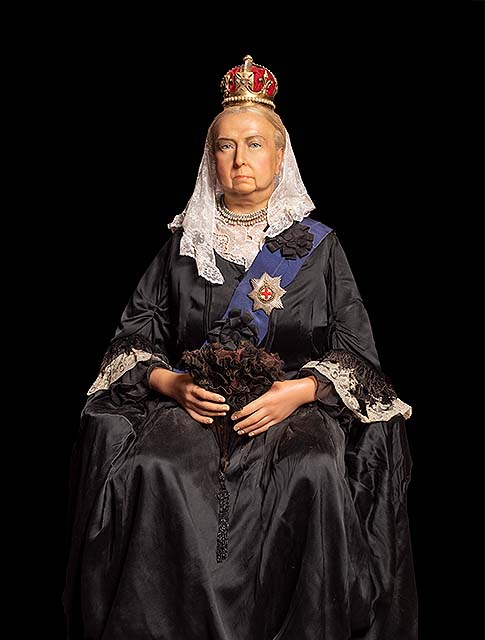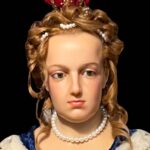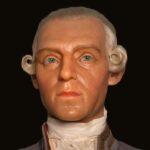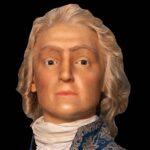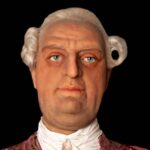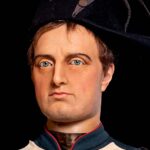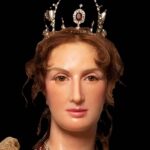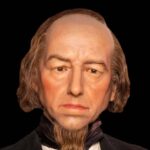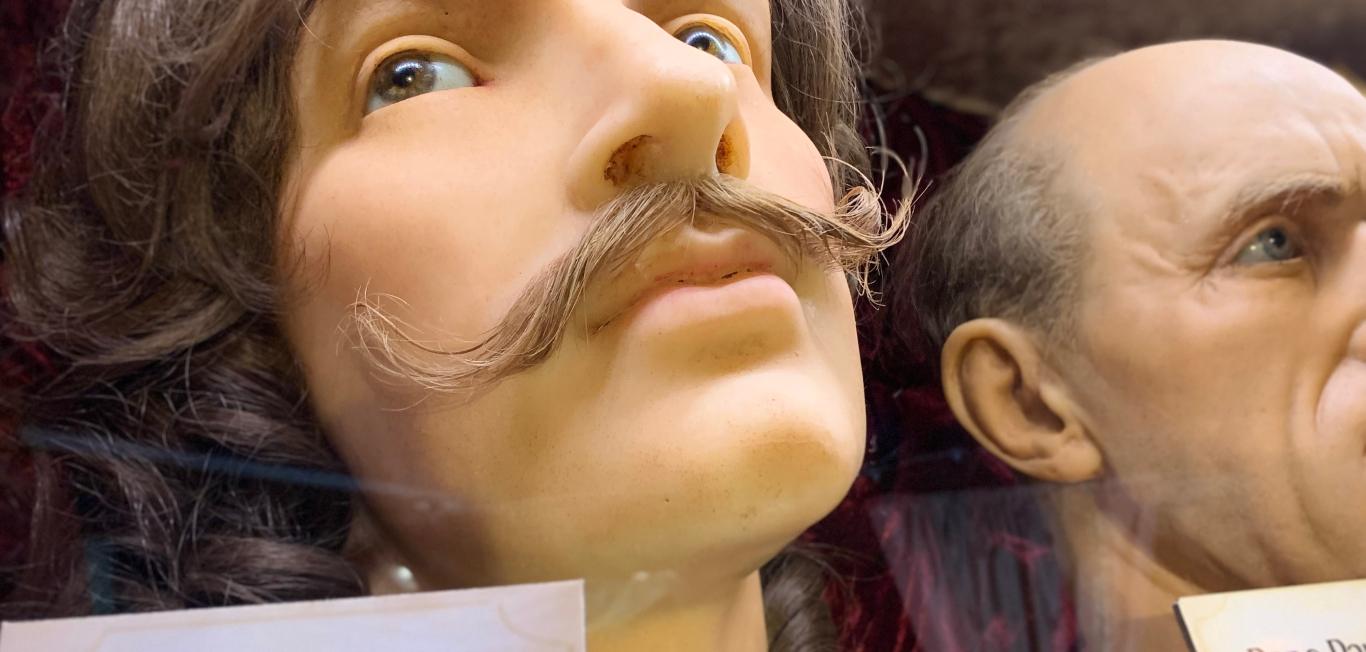About Queen Victoria
Princess Alexandrina Victoria was born in 1819 in Kensington Palace. At the time of her birth, she was fifth in line to the British throne, and by the age of 18, she ascended to the throne and was appointed Queen Victoria. Queen Victoria’s reign was one of the most influential times in British history, and her monarchy lasted more than six decades.
Queen Victoria’s biography notes that she had an arduous childhood and was controlled under the restrictions of the Kensington System, which was developed by the Duke of Kent’s comptroller, Sir John Conroy. The Kensington System was created to manipulate and control Princess Victoria so that Sir Conroy could gain control within the royal family. Despite her isolated and authoritarian childhood, she was strong-willed and resilient thanks to the support and comfort she found in her governess Baroness Lehzen.
Queen Victoria’s reign began in 1837 and would become one of the most well-known eras in world history — the Victorian Era. This era was a transformative time in British history and was most known for its social, political, cultural, and industrial changes. During her reign, she led the British Empire in a constitutional monarchy and oversaw several reforms that would provide a better quality of life in the United Kingdom.
Her personal life played a critical role in the favorability of the public’s perception of the monarchy. Queen Victoria’s marriage to Prince Albert, and their large family, became an example of pleasant family dynamics and added depth and humanity to the queen.
DID YOU KNOW?
Queen Victoria's monarchy lasted more than six decades.
Queen Victoria’s legacy continues today through the output of the Victorian Era. Her interest in governance, culture, and industrial expansion impacted the entire world and continues to influence the British monarchy.
Early Years
Queen Victoria was born as Princess Victoria in 1819. At that time, she was fifth in line to the throne and would spend much of her upbringing in complicated, demanding situations. Though challenging and arduous, Princess Victoria’s childhood shaped her into one of the most renowned monarchs in British history. About eight months after her birth, both her father and grandfather, Prince Edward, the Duke of Kent, and King George III, died in January of 1820, advancing young Princess Victoria’s succession to second in line to the throne.
Princess Victoria’s childhood was authoritarian. Shortly after the death of her husband, the Duchess of Kent, Princess Victoria’s mother, relied on the advice of her advisor Sir John Conroy. Conroy was employed by the Duke of Kent to assist his family. When the Duke of Kent died, Sir John Conroy claimed that he was asked to continue taking care of the duchess and the princess. This gave Conroy the ability to take advantage of the duchess and princess and gain control as a prominent figure in the royal family’s life. Sir John Conroy implemented the “Kensington System,” which was a set of rules and restrictions Conroy used to control and isolate Princess Victoria. The “system,” as it came to be known, made the princess’ childhood miserable due to Conroy’s manipulation and constant surveillance over everything she did.
Princess Victoria showed resilience as she maneuvered her way through the Kensington System. She was strong-willed and found comfort with her governess, Baroness Lehzen. The baroness provided the princess with support and guidance throughout her childhood, and with Baroness Lehzen’s help, Princess Victoria made her way out of the Kensington System, maintaining independence.
In 1837, King William IV, Princess Victoria’s uncle, passed away. This event led to 18-year-old Princess Victoria’s ascension to the throne as Queen Victoria. Her advancement to the throne was achieved independently, without the assistance of the Duchess of Kent or Sir John Conroy. Queen Victoria’s reign would be a revolutionary period in British history, remembered for crucial social, political, and economic changes, including the expansion of the British Empire.
The Kensington System was a cruel, isolating way to govern young Queen Victoria that ended up preparing her for life as one of the longest-reigning monarchs in British history. Queen Victoria faced adversity and other challenges during her rule, but her impact would later become known as the Victorian period, which was an era of cultural and industrial achievements.
DID YOU KNOW?
Queen Victoria's impact would later become known as the Victorian period, an era of cultural and industrial achievements.
Personal Life
The most known components of Queen Victoria’s personal life were her marriage to Prince Albert, her artistic talents, and her dog, Dash. Queen Victoria married her first cousin once removed, Albert, on February 10, 1840, at the chapel at St. James’ Palace. Their marriage was arranged, but over time it grew into a loving partnership, and the two had nine children together. Queen Victoria’s affinity for the arts and culture led to her developing skills in singing and drawing. She took singing lessons from opera singer Luigi Lablache and studied drawing from Richard Westall, who is most known for his portraits of Lord Byron. Most of all, she adored her dog, Dash. Dash was a constant presence in her life, providing companionship and comfort through the triumphs and trials of life. The things she enjoyed in her personal life added depth and humanity to the way she was viewed as a ruler and role model in the monarchy.
Interesting Facts
Queen Victoria was a significant figure in British history. Her reign lasted six decades and she left a profound impact on the British Empire, which later would be recognized as the Victorian Era. Queen Victoria was known for having a range of interests and talents. Here are some interesting facts about Queen Victoria that you may not know:
Her first name was not Victoria. In fact, Queen Victoria was actually born as Alexandrina Victoria. She later opted to use Victoria as her regnal name when she ascended to the throne. Since ancient times, monarchs and popes have opted to use a name other than their given name during their reign. This practice identifies the years of their reign and is also how they are identified in historical texts.
Queen Victoria was the first member of the royal family to reside at Buckingham Palace. When she became queen in 1837, she moved into Buckingham Palace, making it her primary residence throughout her reign. For the next 185 years, Buckingham Palace would be used as the official royal residence.
By the age of 18, Queen Victoria ascended to the throne and was appointed Queen of the United Kingdom. She became one of the youngest monarchs in British history when she began her reign, which started following the death of her uncle, King William IV.
Queen Victoria was gifted in language and could speak fluently in English, German, French, and Hindustani, among several others. This skill enabled her to communicate easily with foreign diplomats and dignitaries.
Queen Victoria survived several assassination attempts. Her survival of the numerous threats on her life during her reign is said to be a demonstration of her resistance and determination to execute her role as a monarch.
Queen Victoria unknowingly carried and passed on a hereditary disorder called hemophilia. She is one of the first known carriers of this genetic mutation, which became known as the “Royal disease.” Hemophilia is a bleeding disorder where the blood doesn’t clot correctly. This disorder affected several royal families, most notably, the Russian Romanovs.
Queen Victoria ruled for 63 years and 216 days. This makes her the second-longest reigning British monarch. Her great-great-granddaughter, Queen Elizabeth II, is the only monarch to have surpassed her.
What is Queen Victoria Most Known For?
Queen Victoria is one of the most iconic and longest-reigning monarchs in British history. She is known for her evasion of several assassination attempts, her cultural contributions, and her steadfast governance of the United Kingdom. Queen Victoria’s reign lasted just shy of seven decades and remains one of the most transformative periods in British and world history.
Queen Victoria reigned during the 19th century, a period noted for significant historical events. Some of the events Queen Victoria oversaw in this time period included the global expansion of the British Empire, industrialization, and cultural and scientific advancements. Queen Victoria showed great interest in the progress of her monarchy and was a central figure in these revolutionary developments. Her leadership and poise played a crucial role in maintaining the stability and prosperity of the United Kingdom, as well as in expanding its territory across continents.
DID YOU KNOW?
Queen Victoria is known for her evasion of several assassination attempts.
The Victorian Era is named after Queen Victoria’s reign and is known for its unique cultural, social, and political components. In fact, Victorian architecture refers to a style of homes that were built during Queen Victoria’s rule. Many of these Gothic and intricately designed homes are still standing today across the world. The Victorian Era was a time of high society, with notable advancements in art, literature, and science. In this era, Queen Victoria used foreign policy to protect imperial interests, and she was an advocate of reforms for education, labor, and public health. Her advocacy for reforms led to the construction of sewage systems and public parks, expanded education for the working class, as well as improved living and labor conditions, and the regulation of child labor.
Political and Diplomatic History of the Victorian Era
Queen Victoria reigned during a transformative period in British history. One of her most notable victories was restoring the monarchy’s reputation through political and diplomatic endeavors. Queen Victoria’s success in the development of the United Kingdom and the British Empire was made possible through the following events.
At the age of 18, Queen Victoria ascended to the throne following the death of her uncle, King William IV, on June 20, 1837. This event was the beginning of the Victorian Era, which would transform the future of the British Empire. Throughout the early years of her reign, the government was led by Whig Prime Minister Lord Melbourne. Under the guidance of Lord Melbourne, Queen Victoria learned how to rule within a constitutional monarchy and retain political stability. In 1845, Victoria Day was established in Canada, and it continues to be celebrated today as a federal holiday. Not only is Victoria Day a celebration of her birthday, but it also celebrates the culture and heritage of Canada.
In 1867, Queen Victoria achieved several accomplishments, most notably, the British North America Act, the Royal Assent and Confederation, and the Expansion of Franchise (the Second Reform Act). The British North America Act, now known as the Constitution Act of 1867 was enacted in February and was a pivotal moment in Canadian history, as it set the groundwork to unify the Canadian provinces. By March, Queen Victoria granted royal assent to the British North American Act, which went into effect on July 1, 1867. This date, deemed Canada Day, is a national holiday in Canada, as it marks the start of Canada being a self-governed entity within the British Empire. In an effort to broaden political participation and representation in the United Kingdom, the Second Reform Act was passed. This act expanded voting rights, which increased the number of voters.
In her later years, Queen Victoria became an icon and a symbol of the British Empire, as her political and diplomatic accomplishments played pivotal, beneficial roles in the shaping of the modern world and the United Kingdom. Her social reforms and influence, as well as her ability to remain poised and stable through a period of rapid transformation, gained her popularity.
Events of the Victorian Era
As mentioned in Queen Victoria’s biography, her time of rule is known as the Victorian Era and was a time of remarkable change and innovation that shaped the course of British and world history. Here are some of the most significant events from Queen Victoria’s reign.
At the age of 18, Princess Victoria ascended to the throne and was crowned Queen Victoria on June 20, 1837. Her reign would last nearly seven decades.
The British Empire freed 768,000 slaves by August 1, 1838. Queen Victoria’s continuing efforts of abolition, including advancements towards abolishing the transatlantic slave trade gave her reign a moral element that made the British Empire stand out.
On April 8, 1838, a turning point in steamship technology occurred — the S.S. Great Western made its maiden voyage from Bristol to New York.
The London to Birmingham line was completed on September 17, 1838. This railway line’s opening was critical to the continuing expansion of the British railway network.
The Penny Post went into effect on May 6, 1840. Introduced by Rowland Hill, the Penny Post, also referred to as the uniform penny post, revolutionized postal services, and at a standard rate of one penny, allowed for letters to be sent anywhere in the United Kingdom.
In September 1845, Ireland’s potato crops were devastated by potato blight, a type of water mold that causes premature rotting. The Irish Potato Famine lasted until 1852, which severely impacted Ireland’s quality of life and led to mass emigration from that British territory.
To improve the standard of public health and sanitation, the Public Health Act was passed in August 1848.
The Great Exhibition of the Works Industry of All Nations was the first ever international exhibition of manufactured products. The exhibition was located in Hyde Park and was open from May 1 to October 15, 1851.
One of the most significant international events during Queen Victoria’s reign began on March 28, 1854. Britain and France declared war to support the Ottoman Empire against Russia.
On January 17, 1856, Henry Bessemer invented the Bessemer Process, which made steel production more affordable and accessible.
The Indian Rebellion broke out on May 10, 1857. This led to an uprising against the British Empire.
Charles Darwin’s “On the Origin of Species” was published on November 24, 1859. This publication introduced the theory of evolution by natural selection.
The world’s first underground railway, named the Metropolitan Railway, opened in London on January 10, 1863.
The Suez Canal opened on November 17, 1869. The Suez Canal opened as a shortcut to navigate through Egypt, creating the shortest maritime route from Europe to India.
In March 1876, Alexander Graham Bell received the patent for a revolutionary communications device, the telephone.
The Elementary Education Act went into effect on August 2, 1880, making school attendance for children aged 5-10 compulsory.
The Woman’s Franchise League was founded on July 25, 1889. This organization was established to advocate for women’s suffrage and equality.
How She Lived Out the Remainder of Life
Queen Victoria died at the age of 81, from a cerebral hemorrhage, on January 22, 1901. She was an iconic monarch who reigned for six decades and left a lasting legacy, the Victorian Era, which continues to shape the cultural achievements of the British monarchy in the UK and around the world.
In her later years, Queen Victoria suffered from several health complications, including rheumatism and cataracts. Despite these challenges, she continued to rule with decorum. In true Queen Victoria fashion, she planned her own funeral. This solemn sacrament was a military affair, as she used this event to give tribute to her father’s military service. As a symbol of her love for her husband Prince Albert, Queen Victoria was laid to rest in a white dress and her wedding veil.
DID YOU KNOW?
In true Queen Victoria fashion, she planned her own funeral.
Queen Victoria’s coffin was filled with sentimental mementos from her loved ones and servants that would be with her for eternity beside Prince Albert at the Royal Mausoleum at Frogmore within Windsor Great Park. The passing of Queen Victoria marked the end of the Victorian Era, a time of social, political, and economic changes, as well as cultural growth.
FAQs
How long did Queen Victoria reign?
Queen Victoria reigned from June 20, 1837, to January 22, 1901, equating to 63 years and 216 days.
When was Queen Victoria born?
Queen Victoria was born Alexandrina Victoria on May 24, 1819, at Kensington Palace in London, England.
Where is Queen Victoria buried?
Queen Victoria is buried at the Royal Mausoleum at Frogmore, which is within the property of Windsor Great Park.
What did Queen Victoria die of?
On January 22, 1901, Queen Victoria passed away from a stroke caused by bleeding of the brain, known as a cerebral hemorrhage.
How many children did Queen Victoria have?
Queen Victoria and her husband Prince Albert had nine children together. Their children were Victoria, Princess Royal; Albert Edward, Prince of Wales; Princess Alice; Prince Alfred; Princess Helena; Princess Louise; Prince Arthur; Prince Leopold and Princess Beatrice. Her descendants would later become interconnected throughout European royal families, which earned her the nickname “Grandmother of Europe.”
